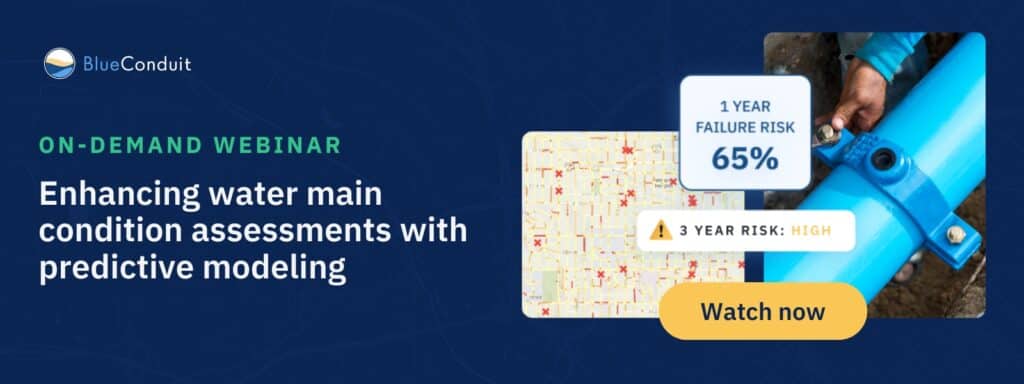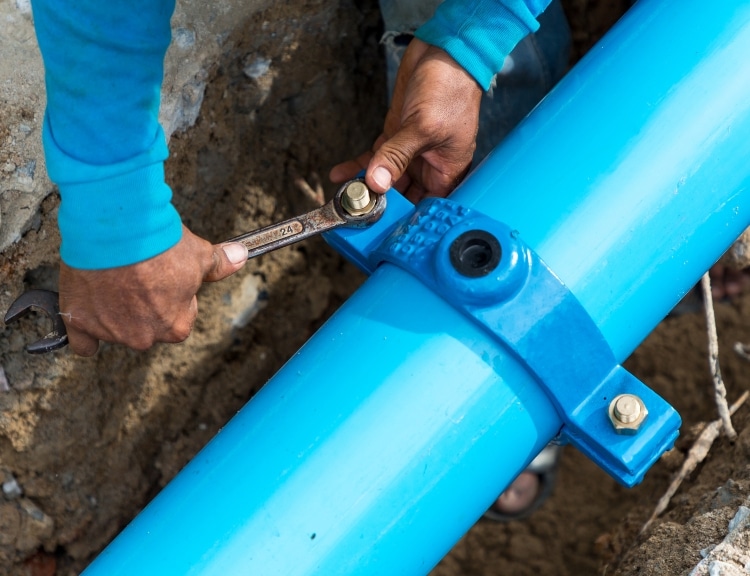Let’s face it: reactive water infrastructure management isn’t working. By waiting for water mains to break before taking action, utilities risk high, unanticipated costs, public disruption, safety concerns, and loss of community trust.
So, what does it look like to move from reactive to proactive when it comes to water main management?
Proactive water main management requires data and analytics, including predictive modeling, to help the utility understand and assess their risk profile. This assessment then enables a range of proactive interventions. The American Water Works Association (AWWA) recommends utilizing condition assessment to gauge and manage system risks. But what is condition assessment, and how does predictive modeling fit in?
What is condition assessment?
As defined in the AWWA’s M77 manual “Condition Assessment of Water Mains,” condition assessment is the proactive evaluation of water mains using a variety of methods, which allows a utility to gather data for risk-based decision making. The goal of condition assessment is to avoid breaks with proactive intervention.
Intensive physical condition assessment could, theoretically, provide a complete view of risk in the system but this is unrealistic from a resource and cost-benefit perspective. Why? First, it is unrealistic to assume that any utility has the resources to adequately, continuously monitor the status of buried water main infrastructure.
Second, this is not a good use of resources. Different water mains have different risk profiles and it is most efficient for utilities to direct more resources toward high-risk mains. The AWWA uses a simple analogy to explain the concept: a young, healthy individual may only require a few basic health tests every several years, while an older person with chronic problems may require many tests performed more frequently. Similarly, a higher-risk pipeline will require more attention than a lower-risk pipeline.
How is risk defined in condition assessments?
Risk assessment is the linchpin of condition assessment. Broadly, the M77 defines risk as:
Risk = (Likelihood of failure) * (Consequence of failure)
Likelihood of failure (LoF) is exactly what it sounds like: the likelihood of a water main to fail during a specific time period. Consequence of failure (CoF) is the negative financial, social, and environmental impact that could occur if the main fails.
By analyzing and assigning risk scores to every water main, utilities can use condition assessment to identify their greatest risks and take action to address problems before pipes fail; action can range from additional assessment to maintenance to full replacement.
The method(s) used for risk assessment is critical here; gaps in the dataset or low quality analytics can bias or misrepresent the actual risks inherent in the infrastructure, leading a utility to inefficiently distribute resources and struggle to mitigate water main breaks. This is where predictive modeling comes in.
How can predictive modeling help assess risk?
The M77 lists a variety of methods that can be used to assess risk, including predictive modeling. The manual notes that predictive modeling can be especially useful in situations where the current condition of a pipe is unknown, inaccessible, and/or cost-prohibitive to capture.
Essentially this means that any dataset with gaps in knowledge (aka, every water main dataset) can likely benefit from predictive modeling to fill in those gaps for a more complete picture of risk, which guides proactive intervention.
The M77 specifically recommends a progressive approach to condition assessment, starting with simpler, less intensive & less expensive approaches, and then progressing to more invasive & more expensive tests if the simpler tests indicate that the pipe is in poor condition.
Predictive modeling is a perfect example of a non-physical, affordable approach that enhances a utility’s understanding of risk far more accurately than weighted or regression models and ahead of physical condition assessment tactics. Predictive modeling brings together water main, parcel, soil, weather, demographic, and other datasets to create a multidimensional view of risk for every water main.
This type of analysis easily enhances pre-existing condition assessment processes, and it is a great starting point for utilities just getting serious about proactive main management. Predictive modeling can be used ahead of physical tactics to guide decisions about high priority physical assessment. It can also be used to directly influence plans for short-term maintenance or long-term capital improvement projects.
If you’re serious about proactive water main management, predictive modeling is the best analytical tool available, at a fraction of the cost of more extensive, less complete physical assessment approaches.
Ready to learn more about how predictive modeling can fit into your water main management approach? Watch this webinar!






